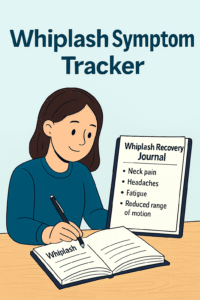When I first got whiplash, I honestly didn’t think tracking my symptoms would help much. I figured if the pain was bad, I’d know and if it got better, I’d feel it. But the reality is: healing from whiplash is rarely a straight line. One day you might feel decent, and the next day you’re sore, tired, and tense all over again, without really knowing why.
That’s when I started keeping track. Not just of the pain, but of everything around it: how I slept, what I did that day, how much I moved, and how I felt emotionally. Slowly, patterns started to appear. Days where I sat too long or skipped stretching were usually worse. Gentle walks helped. Stress made everything tighter. Writing it down gave me back some control and that mattered a lot.
Why Track?
Tracking helps you:
- Spot patterns and triggers
- Measure real progress (even small wins!)
- Communicate more clearly with your doctor or physio
- Feel more in control of your recovery

What to Track
Use the Self-Assessment below as your starting point. You can do this once a week, or whenever symptoms change. Keep your notes somewhere you can look back on. A notebook, a Google Doc, or use the downloadable template provided.
1. Range of Motion & Stiffness
Start by gently moving your head in all directions. Left, right, up, down, and side-to-side. Don’t push into pain.
💬 For me, looking to the left was blocked for weeks, and I had occasional cracking noises that felt scary at first. Over time, I realized those sounds were mostly just tight joints releasing pressure, not a sign of damage.
Write down:
- Which directions feel limited
- Where you feel stiffness or resistance
- Any cracking, popping, or grinding (and whether it hurts)
2. Muscle Tension & Soreness
Gently press around your neck, shoulders, and the base of your skull. Feel for sore spots, tension, or areas that seem “locked.”
💬 Personally, the base of my skull was incredibly tight — like it was always bracing. I also had a hot spot left of my spine that flared up after stressful days or bad sleep.
Write down:
- Which muscles are sore or tense
- If tension worsens after specific activities
- Changes over time (better/worse)
3. Nerve Sensations (If Any)
Notice any tingling, numbness, or weakness in your hands, arms, or shoulders. These can be signs of nerve involvement and should be taken seriously.
💬 I didn’t have nerve symptoms, which was reassuring. But if I ever did feel a weird electric jolt or numbness, I made a note of it to bring to my physio.
Write down:
- Any unusual sensations (tingling, buzzing, numbness)
- Whether movement makes it worse
- Any changes in grip strength or coordination
Keep It Simple
You don’t have to write a full report every day. Even just jotting down a few bullet points a couple times a week can be incredibly helpful. I like to include a short note on my sleep, stress levels, and activities, since all three affect how I feel physically.
The point isn’t to be perfect. It’s to start noticing your body’s signals again. Whiplash can disconnect you from yourself. Tracking is a way to slowly rebuild that connection.
Further Reading
